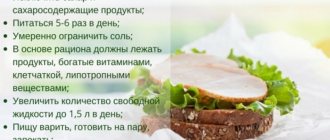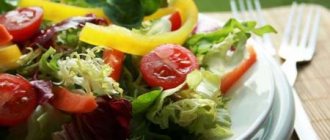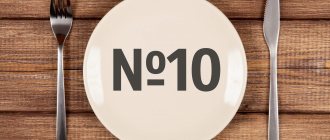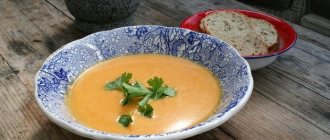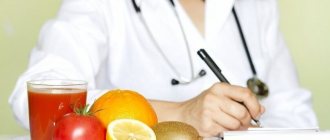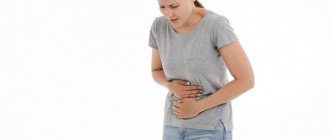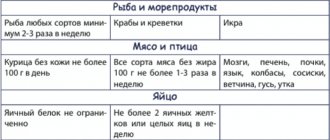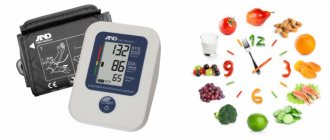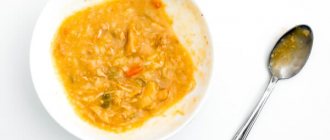The scientific foundations of diet therapy were developed in the 19th century, when they began to study in detail the physiology and chemistry of nutrition, protein balance, and determined the required amount of minerals and vitamins in the daily diet. A little less than a hundred years ago M.I. Pevzner developed a group system of therapeutic nutrition that took into account the most common diseases.
Diets were initially used only in large hospitals and resorts, and then, since they had proven their effectiveness, they were introduced into the practice of all hospital institutions. The diet is prescribed based on the nature of the disease, the characteristics of its course, the presence of concomitant pathologies, and the patient’s taste preferences.
Necessity and principles of diet No. 3
Dietary nutrition corresponding to table No. 3 is recommended when the patient suffers from constipation, including that accompanying chronic gastrointestinal diseases. Children's intestines often do not have time to adapt to the menu and work fully, which also causes problems with bowel movements. The standard third table menu for children is supplemented with food that has a laxative effect. Basic principles:
- strict diet (at certain hours, food portions are small, breaks between meals should be approximately the same);
- in diet number three, the amount of salt, carbohydrates, proteins and lipids consumed is strictly limited, and a drinking regime is established (1 ½ liters of liquid per day);
- The calorie level of the diet is determined based on the patient’s age norm.
General recommendations
- The “3 table” diet should help enhance intestinal motility, so its basis can be considered vegetables and fruits rich in fiber and foods that provide a laxative effect
Important! There will be no benefit from dietary nutrition if you do not follow the drinking regime. You need to drink at least two liters of clean water per day.
- You need to sit at the table 4-6 times a day, portions should not be large.
- The “Table 3” diet should have the following calorie content - 3000 Kcl per day
- The amount of salt consumed is no more than fifteen grams per day
- The Table 3 diet menu, as we have already said, includes a lot of vegetables and fruits. Vegetables can be boiled, baked or stewed.
Important! A third of the total amount of vegetables and fruits must be eaten fresh.
- All products that can cause fermentation and putrefaction in the intestines are excluded.
Table of permitted and prohibited foods and drinks
Dietary table No. 3 involves a certain list of permitted and prohibited drinks and food products. The first includes foods that weaken - vegetables, fruits and berries; the second list includes everything that impairs intestinal motility and can increase constipation, for example, potatoes, semolina, smoked meats.
READ ALSO: What should a child’s diet be like for constipation?
A detailed list of products can be found in the table below.
| Category | Products | |
| Allowed | Prohibited | |
| Compotes and juices | Rosehip, apricot, carrot, plum, tomato and pumpkin juice. | Kissel. |
| Soft drinks | Sweet black tea with milk, mineral water, instant chicory (more details in the article: is it harmful to drink chicory while breastfeeding?). | Instant coffee, black tea, cocoa (see also: what does E. Komarovsky say about drinking coffee while breastfeeding?). |
| Oils, fats | Oils: butter, sunflower, corn, olive. | Cooking and animal fat. |
| Fish | Herring. | Smoked, canned. |
| Egg | Chicken in the form of a steam omelette or soft-boiled. | Fried and hard-boiled. |
| Bird | Turkey, chicken. | Goose, duck (including smoked), smoked chicken. |
| Meat | Rabbit and calf meat. Beef, including liver and tongue. | Pork, lard. |
| Cheese, cottage cheese | Cottage cheese. | Spicy cheese. |
| Dairy | Yogurt, milk, kefir, kumiss, sour cream, yogurt, cream. | – |
| Confectionery | Pastille, jam, marshmallows, jelly, fruit and berry marmalade. Milk or fondant candies. Oatmeal cookies for children or “Maria” (see also: how many Maria cookies can you eat per day while breastfeeding?). | Pastry cream, chocolate. |
| Bakery products | Whole grain or doctor's bread. Bread – bran, rye or oatmeal. | Wheat bread. |
| Porridge | Barley, millet, pearl barley, corn, oatmeal, buckwheat. | Rice, semolina, sago. |
| Dried fruits | Prunes, dried apricots, apricots, dried figs. | – |
| Fruits | Apples, nectarines, plums, peaches, bananas, melons, watermelons, apricots (see also: is it good for a nursing mother to eat watermelon?). | Dogwood, quince. |
| Vegetables | Tomatoes, pickles, pumpkin, zucchini, carrots, beets. Cabbage, including sauerkraut or cauliflower. | Garlic, horseradish, turnip, white radish, radish, potatoes. |
You should also keep in mind that mushrooms, blueberries, pasta and noodles are prohibited. Mayonnaise and mustard should not be consumed. During the diet you will have to give up dry-cured sausage.
Those with a sweet tooth will be pleased by the fact that sugar and honey in this case are included in the list of permitted products.
Diet result
Diet is a powerful helper for the body during exacerbation of intestinal disease. Proper nutritional therapy helps to get rid of the symptoms of the disease, and sometimes completely cure intestinal diverticulosis even without drug intervention. But drug treatment without diet is much less effective.
The disease can be prevented with proper nutrition. By consuming healthy foods in moderation and at the right time, you can make your body highly resistant to various diseases. After treatment for the disease, especially after diverticulitis, you should stick to the therapeutic diet for some more time, or better yet, completely reconsider your diet for the rest of your life.
https://youtu.be/CqO3HJoC2-A
Diet menu No. 3 for a week for children
Diet No. 3 involves dietary restrictions, but this does not mean that children’s nutrition should be meager. From permitted products, you can prepare many healthy dishes that will appeal to a 2-3 year old child and a schoolchild and will help his intestines work properly (we recommend reading: nutrition for a 3-year-old child: menu). What dishes to prepare with a laxative effect? Below is an example of a menu for the week.
READ ALSO: nutrition of a child at 2 years old: what should the menu be like at this age?
Monday
- For breakfast, offer your baby oatmeal porridge, a light tomato salad, a piece of low-fat cheese and a glass of coffee drink.
- At noon he will have a snack of shredded cabbage salad with grated carrots.
- For lunch, bake veal with vegetables, make kefir kholodnik and cook compote.
- Dine with plum juice and millet cereal. At night - kefir.
Tuesday
- At 9:00, milk porridge with prunes, biscuits and a mug of chicory drink with honey will appear on the table.
- Afternoon snack – fruit salad with honey and nuts.
- For lunch - pearl barley soup with chicken broth, vegetable stew and compote.
- In the evening, serve vegetarian cabbage rolls, biscuits and a vitamin broth of rose hips, and before bed - figs and yogurt.
Wednesday
- Buckwheat porridge, cottage cheese with sour cream and diluted juice - breakfast.
- After 3 hours – carrots with sour cream and a glass of compote.
- Lenten soup, stewed hake and zucchini-cabbage stew for lunch.
- Dinner – baked cabbage cutlets with oatmeal, juice. At night - acidophilus.
Thursday
- Cottage cheese, milk porridge made from buckwheat with added bran and a coffee drink will give you a boost of energy.
- At 12:00 - a snack with yogurt and fruit, and at 15:00 - a hearty meal (beetroot soup, vegetable casserole, some boiled chicken and juice).
- For dinner, stuff the peppers with cottage cheese and prepare a beet salad with prunes. Before going to bed - kumys.
Friday
- In the morning – dried fruit puree. Your morning meal will be complemented by oatmeal cookies, a steamed omelet and a mug of tea with honey.
- A fresh apple with biscuits is suitable as a snack.
- For lunch, the child will drink a glass of tomato juice, taste baked fish, and try vegetable soup.
- A couple of vegetable cabbage rolls, buckwheat and a glass of plum juice will make up an evening meal.
Saturday
- Milk oatmeal and fresh fruit will set a positive mood.
- At 12 o'clock the baby will eat baked cheesecakes with natural juice (we recommend reading: how to prepare cheesecakes for 1-year-old children?).
- In the afternoon, a hearty meal - a plate of lean cabbage soup, a piece of boiled veal, carrot puree and a mug of rosehip drink.
- For dinner, bake carp or pike and serve broccoli salad with the fish. Late snack – some prunes.
Sunday
- The morning begins with tender curd pudding and fresh berries.
- Afternoon snack – apple and oatmeal cookies.
- For the first day - borscht without meat, whitened with sour cream, for the second - a piece of boiled turkey, delicious compote.
- The child will have dinner with vegetable cabbage rolls, buckwheat casserole, and at night - yogurt without additives or kefir.
General principles
Nutrition for intestinal diverticulosis has general rules, but it is impossible to create a universal menu for every patient. Firstly, due to the individual reaction to foods: one person tolerates foods well, which in most people provoke gas formation (pea puree, cabbage, prunes), while another person experiences flatulence at the slightest deviation from the diet. Therefore, the menu must be selected individually, focusing on sensations, but starting from general principles.
Diet during exacerbation
Nutrition for acute diverticulosis or during an exacerbation should be as gentle as possible. Any food that can irritate the mucous membrane of the digestive tract is completely excluded: spicy, indigestible, rough, fried foods. Any food is pureed, the juice is strained from the pulp.
If the clinical picture is severe, complete abstinence from food may be indicated in order to remove the load from the intestines as much as possible. Nutrition is provided intravenously, but this approach can only be carried out in a hospital under the supervision of a doctor.
Diet for remission of intestinal diverticulosis
Approximately 1 week after suffering an acute pathology, it is necessary to switch to a diet that activates intestinal motility. Fiber is responsible for this function - contained in vegetables, fruits, or in finished form sold in health food stores. Fiber stimulates gastrointestinal motility, swelling upon contact with water, making stool softer. But for this, a person must consume a sufficient amount of water (1.5-2 liters, if there are no contraindications from the kidneys or endocrine system).
Exactly how much fiber you should eat daily is an individual question. The average for an adult is 30 g of fiber, but you need to start from your own well-being. Flatulence, bloating and abdominal pain are signals that there is a lot of plant fiber in the diet. Therefore, fiber must be reduced to an amount that will be well tolerated by the body.
It is important not to change your diet suddenly. You need to gradually switch to a diet rich in fiber. First, you need to analyze your breakfast, determine which foods are low in plant fiber, and replace them with fiber-rich ones. After a few days, you need to change lunch in the same way, and after the body gets used to it, dinner.
Some useful recipes
Baked fish with vegetables
Cut 0.3 kg of pike or carp into bite-sized pieces. Grease a baking sheet with oil and place the fish pieces. The next layer will be diced zucchini, then tomatoes and cauliflower. If your child loves carrots, you can grate them on a coarse grater and sprinkle them on the dish. Bake in the oven for half an hour.
INTERESTING: what to do if a child has severe constipation?
Pumpkin with honey sauce
Cut the pumpkin into large cubes with a side of 4-5 cm, place on a baking sheet and place in the oven, preheated to 150 degrees. After half an hour, take out the baking sheet and pour honey evenly over the pieces (you will need 2-3 tablespoons), place in the oven for another 5-7 minutes.
